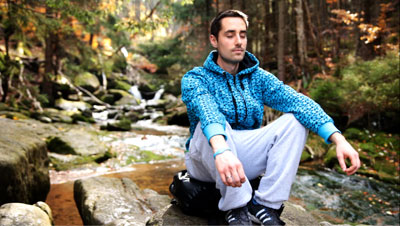So the first part of the program will be theoretical, I’ll be speaking about the philosophy of meditation. And then the second part will be practical, we’ll actually do meditation.
Before I begin, I would like to offer my obeisances to my spiritual masters. They taught me this mediation many years ago. Since that time, I’ve applied it to my life on a very regular basis. And I can insure you that it does work.
All this information I present comes from the Vedic scriptures. The Vedas are very ancient. They were written down 5 000 years ago. But, of course, the knowledge itself is eternal. So prior to being written down, it was passed down orally from one perfect master to the next. And such a line of perfect teachers is known as a disciplic succession, or a parampara. We are in the parampara which is known as the Brahma Sampradaya. And we feel very fortunate to receive our knowledge through this lineage.
So having said this, it’s obvious that this is not my opinion. I’m not here to give you my opinion about meditation. I’m not here to teach you something I learned on top of the mountain one day. I’m just passing on this eternal science.
 Now, throughout the world we find, more and more, people are interested in meditation. Even professional people like doctors and psychiatrists are referring their patients and clients to meditation courses, meditation classes. And when we think of meditation, normally we think of a silent process where we sit down, oftentimes we cross our legs, close our eyes, and then engage in some internal activity.
Now, throughout the world we find, more and more, people are interested in meditation. Even professional people like doctors and psychiatrists are referring their patients and clients to meditation courses, meditation classes. And when we think of meditation, normally we think of a silent process where we sit down, oftentimes we cross our legs, close our eyes, and then engage in some internal activity.
And there are many different techniques. One is called visualization, where we sit down, close our eyes, and visualize beautiful scenes in nature. Very calm and very soothing.
Then another technique is called the silent witness technique, where we become the silent witness to the activity of the mind. Now, of course, we know the mind’s activity is thinking. So we observe our thoughts as they go across the screen of our mind, just like we were watching a movie. We don’t take part, we don’t get involved. We remain the silent witness.
Many years ago in martial arts I learned a simple meditation. We would go in a dark room, light a candle, and focus on the flame. The idea was to develop one-pointed concentration.
Another is called drilling the breath, where the meditation is on the ingoing and outgoing breath at the tip of the nostril.
So many different techniques. But the idea is: we are trying to reach a level of perfection where we have no thoughts. I’m sure that some of you have done silent meditation. And if so, you’ll probably also agree you didn’t quite reach that perfection. So we sit in our meditation, we apply our technique, thoughts slow down, we become very peaceful, and it might be a brief moment when it seems like we have no thought. And invariably we go, “I’m not thinking anything!” And that’s a thought. And then we think, “Why did I do that?!” Now we’ve got to go back and try to reach that point again.
Also externally silent meditation is very difficult. Number one, you must find a quiet place. That’s not always that easy to do. Number two, you must have the time to meditate. And that doesn’t mean 30 minutes before you go to work or you go to school. If that’s the case, the whole time you’re meditating you’re also wondering, “How much time do I have left?” So you sit in your meditation, “Oh, 2 more minutes… Oh, 5 more minutes…” You can’t do that! It’s disturbing.
Also, we must be able to control the body for a long period of time. Here we are; we’re all sitting in seats. I hope everybody’s comfortable. But I can promise in 15 minutes everybody will move. We don’t stay comfortable very long. So again in our meditation: 5 minutes – no problem, 10 minutes – OK, 15 minutes – the knee starts to hurt. Oh, now we meditate on the knee. A little bit later the back’s uncomfortable. Now we meditate on our back and our knee. Again, disturbing.
Also there can’t be any other people around. And that’s not limited just the people in human bodies. One mosquito can destroy your meditation. Can’t be too hot, can’t be too cold. Etc.
So for these and other reasons also, we’re not going to learn that kind of meditation. We’re going to learn some very easy meditations, it’s very simple, and we will use something that we’re all familiar with.
You see, the main tool in silent meditation is silence. We’re not familiar with silence. Some people are uncomfortable with silence. Some people are afraid of silence. I remember one time I went into a house, television was on in the front room, but nobody was in the room. I went into the kitchen, and there was the person busy in the kitchen. So I asked a question, “Why do you have the television on in there?” And the answer was, “Oh! I like the company. Too quite here. I can’t be alone.”
Yeah, we’re not familiar with silence. But we are familiar with sound. We’re surrounded with sound our whole life.
 Some sound is very calm, very soothing. Once again, in reference to nature. It’s very nice to go into nature and look at all the beauty. It’s also very nice to go into nature, sit down, close our eyes, and listen to the beauty. Listen to the wind in the trees, listen to the birds sing, listen to the water running over the rocks. It is so soothing you can even buy recorded sounds of nature for relaxation purposes.
Some sound is very calm, very soothing. Once again, in reference to nature. It’s very nice to go into nature and look at all the beauty. It’s also very nice to go into nature, sit down, close our eyes, and listen to the beauty. Listen to the wind in the trees, listen to the birds sing, listen to the water running over the rocks. It is so soothing you can even buy recorded sounds of nature for relaxation purposes.
And then some sounds are the opposite: very agitating. For instance, our alarm-clocks. Who likes their alarm-clock? One night one lady said, “I do.” Very unusual. And you know what’s worse than your alarm-clock? Somebody else’s alarm-clock.
Then, of course, some sounds we like a lot. And that’s why we all have our cassette players, CD players, mp3 players. We walk around with walkmans, bringing the sound we like into our life.
Sound is necessary. We communicate with sounds.
 All of the sound I referred to, this is one category which is known as material sound. However there is another category of sound. This is known as transcendental sound.
All of the sound I referred to, this is one category which is known as material sound. However there is another category of sound. This is known as transcendental sound.
Transcendental sound does not originate in this material world. It actually originates in the spiritual world. And it descends to the material world. Because it comes from the spiritual realm, it brings with it spiritual power. And because this spiritual power is present, I don’t have to believe in it, I don’t have to understand it, I don’t have to know what it means, I don’t have to make it work, I don’t even have to have faith in it. All I have to do is come in contact with that transcendental sound vibration. And automatically I receive the spiritual benefit.
We can use the sun as an example. We all know that the sun has great power. This comes to us in the form of sunshine. So we can go out into the sun with any philosophy: the sun is good for me/the sun is bad for me, the sun will burn me/the sun will not burn me. It doesn’t matter what I think. The result will be the same. In fact, when we do get sunburned, we often say, “Oh, I didn’t think I would get burnt today!” It doesn’t matter what we think. The result’s the same. And so it is with transcendental sound.
And actually this is very good news for us. In these other meditations they are only as effective as I am good in making them work. How good am I at finding the quite place, arranging my time, controlling my body, controlling my mind, etc.? That will determine the outcome of the meditation. But with transcendental sound, all these factors are not that relevant. So it’s perfectly suited for the busy lives that we all live today.
